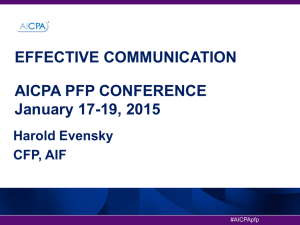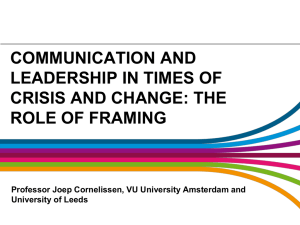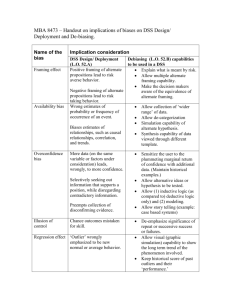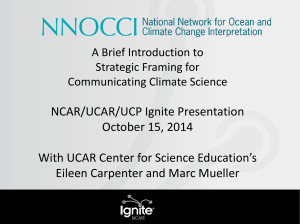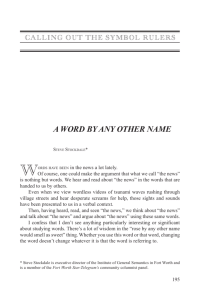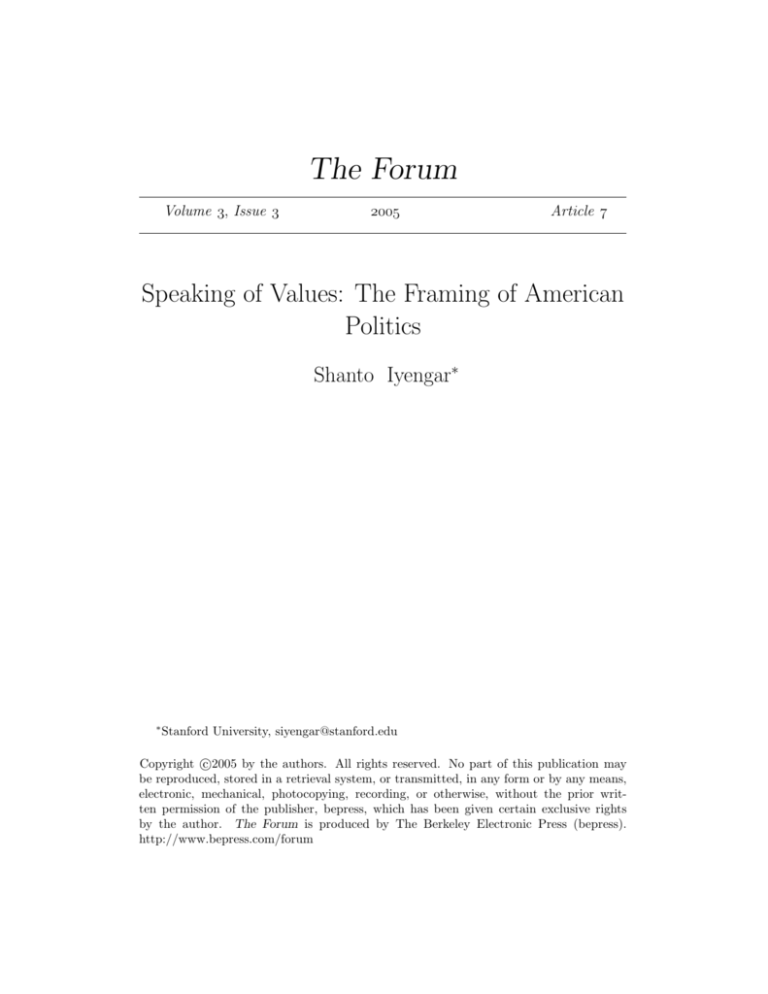
The Forum
Volume 3, Issue 3
2005
Article 7
Speaking of Values: The Framing of American
Politics
Shanto Iyengar∗
∗
Stanford University, siyengar@stanford.edu
c
Copyright 2005
by the authors. All rights reserved. No part of this publication may
be reproduced, stored in a retrieval system, or transmitted, in any form or by any means,
electronic, mechanical, photocopying, recording, or otherwise, without the prior written permission of the publisher, bepress, which has been given certain exclusive rights
by the author. The Forum is produced by The Berkeley Electronic Press (bepress).
http://www.bepress.com/forum
Iyengar: Speaking of Values: The Framing of American Politics
1
In Don’t Think of an Elephant!, the distinguished UC-Berkeley linguist
George Lakoff theorizes that to be persuasive, candidates must integrate their
everyday rhetoric and positions on policy issues into an overarching philosophy
of governance. By practicing such “principled” rhetoric, he argues, Republicans
have overcome their minority standing within the electorate to achieve sustained
control of the White House, Congress, and most state governments.
When George Bush calls for military action against terrorists, federal aid for
religious organizations and the right to life for those in a persistent vegetative
state, Lakoff argues that his principled rhetoric presents him as a conservative
with a deep-seated world view. When John Kerry attacks tax cuts as favoring the
rich at the expense of the middle class, advocates subsidized health care for the
poor, and supports a woman’s right to choose, Lakoff argues that he is presenting
himself as an opportunistic liberal Democrat shopping for votes.
Don’t Think of an Elephant!, an extract from Lakoff’s more expansive earlier
work Moral Politics, made the New York Times bestseller list and is required
reading among the Democratic-liberal intelligentsia. Howard Dean contributed
the foreword. Lakoff is regularly sought out as an advisor by high-ranking
Democrats, including Hillary Clinton and Nancy Pelosi, and has appeared in
person before the House Democratic Caucus. Prestigious news outlets regularly
comment on his ideas. In short, Lakoff is that rarity among academics: a serious
scholar taken seriously by political practitioners.
Lakoff’s diagnosis of the Republican rhetorical edge is based on the following
analysis. American culture consists of two competing worldviews that broadly
correspond to the “strict” versus “nurturing” role of the parent. The first stipulates
that human nature is weak, thus necessitating a “strict father” who resorts to
discipline and punishment to set the child securely on the path of human
development. The “strict parent” outlook is associated with a limited view of the
appropriate scope of government—while governance is necessary to maintain law
and order and protect society from external threats, most domestic problems are
and should be matters of individual responsibility. If people are poor, it is because
they lack initiative; people who are unemployed could find work if they tried
harder; criminals (or terrorists) can and must be effectively deterred from
breaking the law. By this logic, social welfare programs are counterproductive
because they breed dependence instead of self-reliance. Clearly, the strict father
model fits well with the platform of the post-1980 Republican Party.
The Democrats and other progressive groups stand for policies that emanate
from the “nurturing parent” point of view. With appropriate parental care and
nurturance, all children have the potential to develop into fundamentally decent
and productive human beings. This view of human nature as essentially robust
implies a more expansive set of governmental responsibilities focused on the
Produced by The Berkeley Electronic Press, 2005
2
The Forum
Vol. 3 [2005], No. 3, Article 7
realization of the personal potential of all members of society and the elimination
of social barriers impeding normal development.
Given this cultural dualism, what accounts for Republican successes at the
polls despite the greater number of Democrats within the electorate? Lakoff’s
explanation includes the following elements:
1. Lakoff theorizes that because people vote their moral identity rather than
their self-interest, the Democrats lose even when their platform is closer to the
stated views of the median voter. In advocating their policy positions,
Republicans systematically use value-laden catchwords and metaphors (such as
tax relief, partial birth abortion, or “We do not need a permission slip to defend
America”) that invoke the strong father world view. Democrats, on the other
hand, put forward specific positions without value-laden catchwords and phrases.
For example, John Kerry and other Democrats, in response to the Republican
attack on gay marriage, distinguished between civil unions that would confer the
same economic benefits as marriage (which they supported), and same-sex
marriage (which they felt was best left to the church).
2. Republicans, having recognized the importance of language, invested early
in the appropriate infrastructure while Democrats did not. Established think tanks
and a network of talk radio programs provide the talent pool and media platform
for distribution of their message.
3. The political center—often pivotal to the outcome of elections—consists of
voters who subscribe to elements derived from both worldviews. Accordingly, the
task of the politician is to activate or make salient the values that work to his or
her advantage. The Republicans have done so more effectively than the
Democrats.
4. The political left suffers from a paucity of core concepts. Liberals, for
example, are unable to articulate a convincing rationale for taxation beyond the
standard “giveaway to the rich” reaction to Republican tax cuts. Lakoff argues
that if taxes were framed as a patriotic duty, as “citizenship dues” and a form of
national service, then more people would be willing taxpayers.
5. Unlike the right, progressives have yet to discover the value of “strategic
initiatives”: advocacy of a single policy position that leads logically to acceptance
of a host of other positions. In the case of tort reform, for instance, Republicans
not only seek to curb litigation directed at their corporate base (often with massive
jury awards for entire classes of plaintiffs), but also to rein in plaintiffs’ lawyers
who are major donors to the Democratic Party.
Ultimately, Lakoff argues that strategic political communication is pivotal to
election outcomes. The party more capable of integrating issues with values, and
the candidate with the sound bite that more intuitively evokes the triggering
metaphor for the appropriate value system, wins.
http://www.bepress.com/forum/vol3/iss3/art7
Iyengar: Speaking of Values: The Framing of American Politics
3
Despite the enthusiasm with which Democratic leaders have accepted this
story line, I remain skeptical on at least two grounds. First, although political
communication plays a role in influencing voters, there are other significant
factors. The question is one of disentangling the importance of how political
issues are framed as a matter of political communication from other obviously
relevant factors such as the state of the country or voters’ beliefs about the state of
the country. Don’t Think of an Elephant! generally does not acknowledge
alternative explanations; it is a tantalizing theory rather than a demonstrated
conclusion. Second, Lakoff’s theory presumes that political elites are the key
framers of political discourse. However, the scholarly evidence (at least in the
fields of political science and communications) suggests that what gets through to
the public is not the candidates’ rhetoric but rather news media coverage of the
campaign. Modern “interpretive” styles of journalism emphasize dissection, rather
than repetition, of the candidates’ messages.
Alternative Explanations of Elections
In the political science literature on voting, it seems that a candidate’s speech
counts for little. The results of presidential elections can be predicted with a high
degree of accuracy from indicators of economic growth and public approval of the
incumbent administration: voters re-elect the incumbent during times of economic
growth, but opt for change during times of distress. Changes in GNP over the past
year or the level of public approval of the incumbent president four months before
the election are relevant to election outcomes; day-to-day tactics of the candidates
in October seemingly are not (see Bartels and Zaller 2001; Campbell 2004). At
the very least, this evidence suggests that the prevailing political context is just as
important as anything the candidates themselves might say over the course of the
campaign.
But well-entrenched perceptions of the state of the nation and the performance
of the incumbent administration do not make campaign strategies irrelevant.
Campaign professionals know that context matters and they design their content
accordingly. They position their clients to capitalize on the critical issues of
economic performance and national security. During the recession of 1992, the
Clinton campaign fixated on the state of the economy as its core message. In
2004, in the aftermath of the 9/11 attacks and the first stages of the war in Iraq,
President Bush ran for reelection on the ground that he had made the country
more secure from terrorist attacks. To the extent that message framing enters
campaign strategy, it is to define a candidacy on the basis of the current political
issues deemed important by voters.
Lakoff’s account emphasizes the framing of political discourse in terms of
fundamental value systems (e.g. tax relief or permission slips for waging war)
Produced by The Berkeley Electronic Press, 2005
4
The Forum
Vol. 3 [2005], No. 3, Article 7
rather than in terms of specific measures of performance or effectiveness or a
candidate’s personal demeanor. But empirical evidence shows that presidential
elections are fundamentally referenda on the performance of the incumbent
administration, based largely on beliefs about the economy, bolstered by
judgments about the candidates’ relative suitability for the office. Accordingly,
one would expect campaigns to craft their messages to speak to key performance
and image themes. And in fact, they do. In 1992 the Clinton campaign (on behalf
of a client not noted for high moral values) said it succinctly: “It’s the economy,
stupid.”
Cultivation of image is also key. For the 25 percent of the electorate that lacks
a partisan identity, voting is really about “likeability quotients” rather than issue
positions. In 2000, during the first debate with Governor Bush, Vice President
Gore came across as a domineering know-it-all. (In the “Saturday Night Live”
recreation of the debate, Gore offered to sum up for himself and Bush.) In
addition to continually interrupting his opponent and grimacing at Bush’s
answers, Gore incorrectly recalled that he had accompanied FEMA Director
James Lee Witt to an area of Texas devastated by wildfires. The Republicans
seized upon this error and other misstatements (including one concerning his
grandmother’s out-of-pocket expenses for prescription drugs) as further evidence
of Gore’s penchant for exaggeration and bravado. Fanned by Bush campaign
press releases, a secondary “debate” over Gore’s veracity burst out in the media
and on talk radio. Gradually, a significant number of swing voters came over to
Bush on the grounds that Gore played fast and loose with the facts (Johnston et al.
2004). Once again, the “image” issue was one relating to personal traits and not to
fundamental views of human nature and corollary value systems.
What Actually Is Framing and Who Is Doing It?
In essence, Lakoff asserts that the power of political rhetoric derives significantly
from the use of specific words and phrases which have the ability to elicit core
value systems. He cites the well-known speech manuals developed by the
Republican consultant Frank Luntz, who advises his clients to incorporate the
words “healthy,” “clean” and “safe” when discussing the environment, or to make
frequent references to compassion when addressing women. His theory assumes
that people have adequate opportunity to encounter the candidates in their own
words.
But in reality unmediated candidate rhetoric is an increasingly endangered
form of political communication. Today, virtually all political speech is mediated,
either by reporters or pundits. Hallin’s well-known research on the length of the
candidate sound bite in network newscasts documents that on average, voters get
to hear a presidential candidate for six seconds per day (Hallin 1992). While this
http://www.bepress.com/forum/vol3/iss3/art7
Iyengar: Speaking of Values: The Framing of American Politics
5
perhaps provides sufficient time to get in a reference to gay marriage, the more
telling point is that much of what the public encounters during the campaign is
journalistic commentary inspired not by the guiding metaphors of political elites
but by the agendas of their own profession (e.g. to provide an independent view;
to be recognized as the most reliable source of news; to provide color as needed to
attract viewers; and to give the perennial update on the horse race aspects of the
present campaign1). In short, the actual “framers” are increasingly journalists, not
candidates or partisan pundits. Although Lakoff does not deal with media
framing, he does observe that Republicans have invested more in think tanks and
media outlets that provide them with a regular supply of television personalities
and outlets.
No matter the extent to which framing occurs at the level of political elites,
particular candidates or through media interventions, there can be no avoiding the
fundamental definitional question—what do we mean by framing? Lakoff’s use of
the framing concept, which reflects his interests as a linguist, is but one of several
entries in the social sciences. At the most general level, framing refers to the way
in which opinions about an issue can be altered by emphasizing or deemphasizing particular facets of that issue. In psychology, framing theory was
developed as a challenge to the economist’s model of full-information rationality.
In a series of compelling experiments, Amos Tversky and Daniel Kahneman
showed that choices could be reversed simply by defining outcomes as either
potential gains or losses; a program which would certainly save 200 out of 600
people from an outbreak of a rare disease, for instance, was preferred over a more
risky alternative with the identical expected outcome (a 1/3 probability of saving
600) by a majority of subjects. However, when the same choice was presented in
terms of loss (400 certain deaths versus a 2/3 probability of 600 deaths), the
majority now preferred the riskier alternative (see Kahneman and Tversky 1982).
Similar presentation effects occur in surveys. Trivial changes in the wording of
attitude questions can bring about large shifts in public opinion; for example,
people respond far less charitably when asked about the desirable level of
government aid for “people on welfare” than when asked about aid for “poor
people.”
For their part, communication researchers have identified two distinct types of
media framing effects: equivalency framing and emphasis framing. Equivalency
framing, derived from the experiments described above, involves “the use of
different, but logically equivalent, words or phrases” to describe the same
phenomenon, while emphasis framing involves highlighting a particular “subset
of potentially relevant considerations” (Druckman 2001). In Lakoff’s analysis,
1
Virtually every serious study of campaign news has concluded that references to polling and
campaign strategy drown out references to policy issues (Patterson 1994; Farnsworth and Lichter
2003).
Produced by The Berkeley Electronic Press, 2005
6
The Forum
Vol. 3 [2005], No. 3, Article 7
most instances of framing approximate the former category (as in “gay marriage”
versus “same-sex marriage”). In media research, most work on framing focuses
on alternative forms of presentation that differ in more than the choice of words.
Broadcast news coverage of political issues, for instance, falls into two distinct
genres corresponding to thematic and episodic news frames (Iyengar 1991). The
thematic frame places an issue in some general context and usually takes the form
of an in-depth, “backgrounder” report. An example of thematic framing would be
a story about the Iraq war that addressed the historical context of the relations
between the two countries, and the factors that contributed to the current conflict.
Episodic framing, on the other hand, depicts issues in terms of individual
instances or specific events—the carnage resulting from a particular terrorist
bombing, for example. Episodic coverage typically features dramatic visual
footage, while thematic reports tend to be more sedate, consisting primarily of
“talking heads.”
In the United States, episodic framing is by far the predominant mode of
presentation in news stories, largely as a result of market pressures (episodic news
tends to be more engaging for the audience). The preponderance of the episode
frame has serious political repercussions, for exposure to the frame discourages
viewers from attributing responsibility to government. In effect, episodic framing
reinforces the Republican message of limited government.
Lakoff’s cultural dualism can be recast in terms of attributions of
responsibility. Responsibility for most political issues (either responsibility for
causing the issue or for curing it) is attributed either to societal-governmental
forces or to the private actions of individuals. Rising crime, for instance, might be
attributed to youth unemployment and government neglect of inner city areas
(societal responsibility/nurturing parent model), or to innate willingness to break
the law (individual responsibility/strong father model). Similarly, the appropriate
treatment for crime might be either punitive criminal justice codes or greater
attempts to retrain and rehabilitate the prison population. The tendency of people
to gravitate to either societal or individual attributions for issues depends, in part,
on how television frames the issue.
In a series of experimental studies (see Iyengar 1991), more viewers adopted
the nurturing parent model of societal responsibility under conditions of thematic
framing. Following exposure to news reports about increases in malnutrition in
rural areas, study participants discussed poverty in terms of inadequate social
welfare programs; confronted with news accounts of the shrinking demand for
unskilled labor, subjects attributed unemployment to inadequate economic
policies or insensitive public officials; and provided with news reports on
increasing rates of crime in the inner cities, subjects cited improved job
opportunities for the underprivileged as the appropriate remedy for crime. Thus,
when television news coverage presented a collective and impersonal frame of
http://www.bepress.com/forum/vol3/iss3/art7
Iyengar: Speaking of Values: The Framing of American Politics
7
reference, attributions of responsibility—both for causing and curing national
problems—were societal in focus.
When provided with the dominant episodic news frame, however, viewers
attributed responsibility not to societal or political forces, but to the actions of
particular individuals or groups. For example, when poverty, crime, and terrorism
were depicted in episodic terms, viewers’ causal accounts as well as their
prescriptions of treatment responsibility were directed primarily to poor people,
criminals, and terrorists. In response to news stories describing particular
illustrations of these issues, viewers’ attributions invoked individual and group
characteristics rather than historical, social or political forces.
As the discussion above suggests, there are any number of ways of thinking
about framing depending on the disciplinary perspective and what one takes to be
the relevant providers of information. Lakoff’s analysis treats candidates as the
relevant framers; the Republican success is attributed to the superiority of their
campaign rhetoric. For others, news coverage takes precedence over candidate
speech and journalists are the framers of interest. In the analysis of broadcast
news frames, the Republican advantage is attributed to market forces that produce
greater mass exposure to the strict father worldview.
Overall, Lakoff has proposed a provocative account of electoral politics that
highlights the importance of political semantics. Although written for a lay
audience, this is a book rich in hypotheses concerning the psychology of
campaign strategy. As is true with most theorists, the single-minded pursuit of an
argument takes precedence over breadth of coverage. Lakoff’s account does not
come to grips with other equally plausible explanations of voter behavior, some of
which have little to do with language or framing. Lakoff does not seem
particularly interested in subjecting his arguments to empirical testing. One
possibility is that frames interact with political circumstances. Perhaps the strict
father model resonates well with the public during times of military threat, but
sounds discordant when overwhelming natural disasters call for a significant
governmental response (e.g. Hurricane Katrina). Equally problematic is Lakoff’s
focus on candidate speech. Today, voters encounter the candidates primarily
through news reports, and media coverage is increasingly interpretive, with
reporters seeking to explain and deconstruct campaign rhetoric. The real framers
are the news media.
Acknowledgements:
I am indebted to Sam Popkin for a number of editorial suggestions.
Produced by The Berkeley Electronic Press, 2005
The Forum
8
Vol. 3 [2005], No. 3, Article 7
References
Bartels, L. M., and J. R. Zaller. 2001. “Presidential Vote Models: A Recount.”
PS: Political Science & Politics 34: 9-20.
Campbell, J. E. 2004. “Introduction – The 2004 Presidential Election Forecasts.”
PS: Political Science & Politics 37: 733-735.
Druckman, J. N. 2001. “On the Limits of Framing Effects: Who Can Frame?” The
Journal of Politics 63: 1041-1066.
Farnsworth, S. J., and S. R. Lichter. 2003. The Nightly News Nightmare. Lanham,
MD: Rowman & Littlefield.
Hallin, D. C. 1992. “Sound Bite News.” Journal of Communication 42: 5-24.
Iyengar, S. 1991. Is Anyone Responsible? How Television Frames Political
Issues. Chicago: University of Chicago Press.
Johnston, R., Hagen, M. G., Jamieson, K. H. 2004. The 2000 Presidential
Election and the Foundations of Party Politics. New York: Cambridge
University Press.
Kahneman, D., and A. Tversky. 1982. “The Psychology of Preferences.” Science
246: 136-42.
Patterson, T. E. 1994. Out of Order. New York: Random House.
http://www.bepress.com/forum/vol3/iss3/art7


